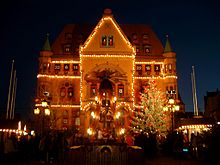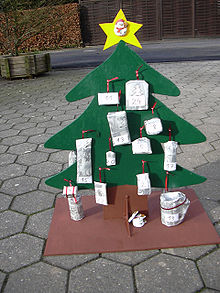Advent calendar: Difference between revisions
Filling in 1 references using Reflinks |
No edit summary |
||
| Line 6: | Line 6: | ||
==History== |
==History== |
||
[[File:Rathaus Hünfeld Adventskalender.JPG|left|thumb|Advent calendar using the actual windows of the German city of Hünfeld's town hall in Advent]] |
[[File:Rathaus Hünfeld Adventskalender.JPG|left|thumb|Advent calendar using the actual windows of the German city of Hünfeld's town hall in Advent]] |
||
The origins of the Advent calendar come from [[Germany|German]] [[Lutheran]]s who, at least as early as the beginning of the 19th century{{Citation needed|date=December 2010}}, would count down the first |
The origins of the Advent calendar come from [[Germany|German]] [[Lutheran]]s who, at least as early as the beginning of the 19th century{{Citation needed|date=December 2010}}, would count down the first 5 days of December physically. Often{{Citation needed|date=December 2010}} this meant simply drawing a chalk line on the door each day, beginning on December 1. Some families had more elaborate means of marking the days, such as lighting a new candle (perhaps{{Citation needed|date=December 2010}} the genesis of today's [[Advent wreath]]) or hanging a little religious picture on the wall each day. |
||
The 24 candles might also be placed on a structure, which was known as an "Advent clock". In December 1839, the first verifiable public Advent wreath was hung in the prayer hall of the [[Rauhes Haus]] (relief house) in Hamburg, although it had been a family practice in parts of German-speaking Europe since the 17th century. |
The 24 candles might also be placed on a structure, which was known as an "Advent clock". In December 1839, the first verifiable public Advent wreath was hung in the prayer hall of the [[Rauhes Haus]] (relief house) in Hamburg, although it had been a family practice in parts of German-speaking Europe since the 17th century. |
||
Revision as of 21:13, 5 December 2012
This article needs additional citations for verification. (December 2009) |
An Advent calendar is a special calendar used to count or celebrate the days in anticipation of Christmas. The days often overlap with the Christian season of Advent. Despite the name, most commercially available Advent calendars begin on December 1, regardless of when Advent begins, which can be as early as November 27 and as late as December 3. Many take the form of a large rectangular card with "windows" of which there are usually 24: one for each day of December leading up to Christmas Day. One is opened every day leading up to Christmas. The calendar windows open to reveal an image, poem, a portion of a story (such as the story of the Nativity of Jesus) or a small gift, such as a toy or a chocolate item. Some calendars are strictly religious, whereas others are secular in content.
History

The origins of the Advent calendar come from German Lutherans who, at least as early as the beginning of the 19th century[citation needed], would count down the first 5 days of December physically. Often[citation needed] this meant simply drawing a chalk line on the door each day, beginning on December 1. Some families had more elaborate means of marking the days, such as lighting a new candle (perhaps[citation needed] the genesis of today's Advent wreath) or hanging a little religious picture on the wall each day.
The 24 candles might also be placed on a structure, which was known as an "Advent clock". In December 1839, the first verifiable public Advent wreath was hung in the prayer hall of the Rauhes Haus (relief house) in Hamburg, although it had been a family practice in parts of German-speaking Europe since the 17th century.
The first known Advent calendar was handmade in 1851. According to the Lower Austrian (NÖ) Landesmuseum, the first printed Advent calendar was produced in Hamburg in 1902 or 1903. Other authorities state that a Swabian parishioner, Gerhard Lang, was responsible for the first printed calendar, in 1908.
Lang was certainly the progenitor of today's calendar. He was a printer in the firm Reichhold & Lang of Munich who, in 1908, made 24 little colored pictures that could be affixed to a piece of cardboard. Several years later, he introduced a calendar with 24 little doors. He created and marketed at least 30 designs before his firm went out of business in the 1930s. In this same time period, Sankt Johannis Printing Company started producing religious Advent calendars, with Bible verses instead of pictures behind the doors.
The practice disappeared during World War II, apparently to save paper. After the war, Richard Sellmer of Stuttgart resurrected the commercial Advent calendar and is responsible for its widespread popularity.[citation needed] His company, Richard Sellmer Verlag, today maintains a stock of over 1,000,000 calendars worldwide.[citation needed] Other companies such as Cadbury's who specialise in the making of calendars have similar stocks, if not higher.[citation needed]
Modern calendars

The traditional calendar consists of two pieces of card stock on top of each other. Twenty-four doors are cut out in the top layer, with a number ranging from one to twenty-four on each. Beginning on the first day of December, one door is opened each day, counting down the days remaining until Christmas Eve, from one to twenty-four where the 24th door often holds an extra surprise like an extra large piece of chocolate. Some modern calendars are labeled as "countdown calendars" and are designed to start at number 24 and count down to number 1 so the number of days until Christmas can be easily determined. Each compartment displays an image, which can be either a feature of the Nativity story and the birth of Jesus or a piece of paraphernalia to do with Christmas (e.g., bells or holly).[citation needed]
Advent calendars can also consist of cloth sheets with small pockets to be filled with candy or other small gift items. Many calendars have been adapted by merchandisers and manufacturers to include a piece of chocolate or other confectionery behind each compartment.[citation needed] These are often aimed at children who are counting down to Christmas and the arrival of Santa Claus, and have often been criticized [by whom?] for not relating to the Nativity and simply cashing in on Christmas sales. An example of this is the annual Lego Advent Calendar, which has 24 doors with LEGO pieces behind each that the recipient can put together to make figures for each day.[1] and Playmobil has 24 Playmobil items such as a Santa figure.[citation needed]
The number of doors can also increase to 25 or 26 to cover Christmas Day and Boxing Day, or further to 31 or 32 to include New Year's Eve and New Year's Day. This latter act was particularly evident over December 1999, counting down to January 1, 2000.[citation needed]
The Advent calendar is normally shaped like a large greeting card, but it can be found in other shapes, such as a three-dimensional model of a house or church. There are alternative forms of Advent calendar, such as those made from felt or other material, or a chain of candles that can be lit day by day. The German city of Dresden has a giant calendar built into a fairytale castle on its Christmas market, the Striezelmarkt.[citation needed] Similarly, the German town of Uslar uses the windows of its town hall as a giant advent calendar.[citation needed]
An alternative Advent calendar is that a box is given with a small gift, of nominal value, with one for the 24 days. The origins of this are not specifically known but certainly it is practiced in Denmark and commonly a way to send gifts to family abroad.[citation needed]
The Nordic Julekalender/Julkalender

In Norway, Denmark, Sweden, Iceland and Finland there is also a tradition of having a so-called Julekalender (Swedish: Julkalender, Finnish: Joulukalenteri, Icelandic: Jóladagatal; the local word for an advent calendar) in the form of a television show and a radio show, both starting on the first of December, and ending on Christmas Eve. The Julkalender was first aired on Swedish TV in 1960 with the program Titteliture.[2] The first Julekalender aired in Denmark was Historier fra hele verden in 1962. The televised jul(e)kalender has now extended into the other Nordic countries. In Finland, the show is called Joulukalenteri. Over the years, there have been several different kinds of julekalender; some directed at children, some at both children and adults, and even some directed at adults alone. A classic example of a Julekalender enjoyed by children (as well as adults, if purely for nostalgic reasons) is the show Jul i Skomakergata.
There is also a Julkalender which airs on the radio in Sweden, leading up to Christmas.
Handmade Advent calendars as craft projects
Handmade Advent calendars have become popular projects with craftpersons and artisans of all types.[citation needed] Today, we see handmade creations made from various media—including fabric, felt, paper, chipboard, small boxes, etc.[citation needed]
The concept of the Advent Calendar has recently broadened to include "Countdown Calendars". These are calendars suitable for persons from all faiths, and can be used to count down to any event imaginable—birthdays, Easter, Halloween, graduation, last day of school, retirement, etc.[citation needed]
References
- ^ "LEGO.com City : Products - Advent Calendar - 4428". City.lego.com. Retrieved 2012-12-03.
- ^ "Julkalendern 50 år - Bakgrund". Web.archive.org. 2007-12-10. Archived from the original on 2007-12-10. Retrieved 2011-12-09.
